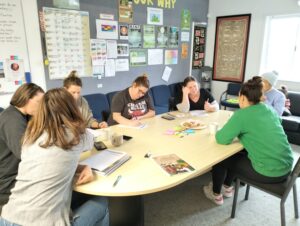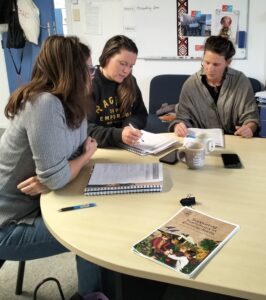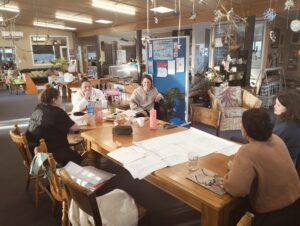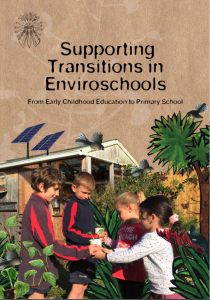Transition from early childhood education to school can sometimes feel like a very scary and overwhelming time in the child’s and parent’s life. By integrating the child’s knowledge and interests, the whānau perspective of the child, and the teacher’s understanding of curricula and the Enviroschools kaupapa, a smooth and empowering transition can be supported.
“Transition from Early Childhood Education (ECE) to school settings is a wonderful time to reinforce the connectedness of our communities and the Enviroschools kaupapa.” – p 4 Supporting Transitions in Enviroschools from Early Childhood to Primary School
I invited two schools and their local Envirokindy teachers to be a part of a series of hui unpacking the Enviroschools transition resource. I sent out a copy of the resource to each teacher to read before our first meeting. They were all enthusiastic about attending the first meeting, held at a local school between 3.30pm – 5pm.
Meeting 1: Establishing a shared understanding

Gathering together to build relationships and knowledge.
Our first meeting was held at Opoutere School. Two teachers from Opoutere School attended, four kindergarten teachers and one teacher from Whangamata Area School. After initial whanaungatanga and setting the intention of our meetings, we took time to dive into the Enviroschools Guiding Principles activity, exploring how they currently looked in their respective settings with teachers noting how they saw each Guiding Principle being applied in their school setting. These were then shared and compared.
This exercise provided a great opportunity to identify similarities and connections across different environments – a base which we could build on for the transition process. It allowed us to reflect on how these principles are enacted in various ways and discover new approaches to engage with them. The discussions that followed were full of valuable insights and a diverse range of ideas, as everyone shared how they saw the principles being lived in their kindergarten or school.
“Connecting with the Enviroschools kaupapa across education sectors is a valuable process for all teaching teams. It provides an opportunity to highlight aspects of the kaupapa that are strengths in each setting as well as identify possible next steps.” P 9 ‘Supporting Transitions in Enviroschools from Early Childhood to Primary School’
We then did a bus stop activity around four questions I had written out on large sheets of paper (see below) to better understand the knowledge and skills that tamariki bring with them when transitioning to school. This also helped us reflect on how we can best support this transition, particularly in relation to sustainability and the Enviroschools kaupapa.
Question One – Current Situation: What skills and knowledge do tamariki bring with them around sustainability and the Enviroschools kaupapa, and how can this be harnessed?

Using the resource ‘Supporting Transitions in Enviroschools’ to understand the current situation.
Some of the main themes that emerged in our discussions were around tamariki advocating for te taiao. This included practices like reducing, reusing and recycling. Other common practices included creating natural resources, such as composting, gardening, and developing māra kai. Many participants shared stories of in-depth projects on topics such as the local dotterel population, worms, bees, atua Māori and Matariki. Overall, it was clear that tamariki were already practicing kaitiakitanga, and manaakitanga, key values of the Enviroschools framework.
Question Two – Exploring Alternatives: How can we incorporate parent and whānau knowledge and experiences to support transition and the Enviroschools journey?
Another important question was how to engage parents and whānau in the transition process. We discussed the idea of inviting parents and whānau to participate actively in the school community. For example, they could bring their expertise to special days like planting days or community days. It’s crucial to create consistency in these relationships through building trust, regularity, whanaungatanga, and hononga (connections). Building respectful and reciprocal relationships will help strengthen the child’s sense of belonging and foster a deeper connection to both the school and the wider community. It was also suggested that we share what’s happening in our settings—such as worm farms or composting—and encourage families to integrate these practices at home.
Question Three – Exploring Alternatives: What ideas do you have for improving the transition space, and what support would you need?
The third question focused on ideas for improving the transition process and what support might be needed. Key ideas that emerged centred around increased sharing and communication. Teachers expressed a desire for platforms to share the child’s learning journey, such as Story Park, profile books, or even a one-page summary of the child’s experiences. Establishing a shared language between settings—whether that be through events, school activities, or a shared waiata, hui, and karakia—was also seen as vital to maintaining connections. Teachers suggested that visits between settings be structured with more intention, both for tamariki and teachers, as this would foster greater continuity and support the transition process. Connecting through community events, such as waka ama, was also highlighted as a way to strengthen these bonds.
Question Four – Exploring Alternatives: Viewing the child as an expert: How can tamariki share their knowledge with schools about their sustainability projects and practices?
We also explored viewing the child as an expert in their own learning, particularly when it comes to sharing their knowledge of sustainability with their new school. Some ideas included making visits between settings more intentional and frequent, encouraging social connections within the community, and creating lasting practices for the transition process that extend beyond the time the child spends at kindergarten. Additionally, sharing children’s learning journeys through PDFs or digital platforms was suggested as a way to maintain continuity in their education.
This is where we ended our first meeting. We had unpacked a lot and would carry on the conversation at our next meeting, continuing to explore ways to improve the transition process and enhance those connections, and also work on implementing new practices that best support tamariki and their whānau as they move from early childhood settings to school.
Meeting 2: How can we take action?

Continuing the kōrero to develop effective transitions.
We began our second session by considering ‘What if?’ questions from page 17 of the transitions resource book. In particular, What if all senior management and the Board of Trustees knew about and supported the Enviroschools programme and the relationships and partnerships of those involved? This sparked a lot of engaging conversation, and it was noted that, overall, the management teams are already on board with supporting the transition process. However, we also discussed whether there’s a need to formally integrate these ideas into strategy and policy. This raised the importance of ensuring that management’s support is not only present but is also embedded within the school’s broader framework and planning.
From here, we moved on to develop an Action Plan based on ideas discussed in our previous meeting. This included exploring alternatives and how we could make visits between kindergartens and schools more intentional and purposeful.
Making Visits More Intentional
I created another bus stop activity using the Action Learning Cycle’s ‘Take Action’ guiding questions to consider how visits could be more intentional. We spent time unpacking how to make visits between kindergartens and schools more meaningful. Two exciting ideas emerged from this discussion. One idea was to have a shared Dotterel Day and a joint protection project, which would bring both kindergartens and schools together to focus on environmental education. This would be an engaging way to get tamariki involved in community sustainability efforts while fostering collaboration between different settings.
The main action to bring everything together was the creation of a shared document to ensure everyone was aligned and aware of their responsibilities.

‘Supporting Transitions in Enviroschools’ resource.
The second idea that came from exploring alternatives was setting clear objectives for visits to each other’s spaces. One example of this could be kindergartens and schools coming together for activities such as adventure learning or planting days. These visits would also serve as an opportunity to build stronger relationships between the whole school and whole kindergarten. Tamariki could take on leadership roles to guide others around their space.
Now that we had unpacked the Take Action guiding questions, there was a clear plan in place and everyone knew their role.
Part of the Action Plan was to explore the importance of sharing knowledge, language, and learning between kindergartens and schools. This idea was explored using the Take Action guiding questions. It was agreed that collaboration between kindergartens, schools and whānau was essential. To facilitate this, they decided to create an Enviro handout that would be passed on to school teachers, sharing important details about the child’s environmental knowledge and interests.
Another key discussion point was how to use the child’s voice to support their transition. We referred to page 7 in the transitions resource on Capturing Child Voice. This tool helps tamariki express how they love to engage with the environment. This can then be shared with the school to build the shared understanding of the child as they transition. This simple, one-page document provides teachers with valuable insights into the child’s interests and strengths, ensuring that their transition is both supported and personalised.
We also discussed using tools like Google Docs and email to facilitate communication and provide updates. A farewell speech was suggested as a way to formally conclude the transition process and celebrate the child’s journey.
Moving Forward – Taking Action
The primary action to bring about these changes was to develop clear communication. One teacher offered to take the lead in creating a Google folder that will hold the shared documents, streamline the process and ensure everyone stays informed. Through regular communication, we can keep all involved parties up to date on the progress of the transition.

Enjoying the Dotterel Day at the local beach.
On the 6th November 2024, Opoutere School new entrants’ class and Whangamata Kindergarten got together at for their shared Dotterel protection project at Whangamata Beach. The teachers tell me they had such an awesome morning together. The kids all mixed and mingled and some of the new entrants’ children sang a song with the kindergarten kids that they had made up together last year about the dotterels.
They had a local expert come and talk to the children about the dotterel protection and then working together they all made ‘nests’ on the beach.
Once back at school, the new entrants drew pictures and wrote stories of their day. Now the plan is to put these into book form to share with the kindergarten tamariki.
When the transitioning children visited the school, they appeared relaxed, feeling comfortable in the school environment and excited to be starting in the new year.
I am continuing my communication with all of the teachers and will hopefully be able to arrange another meeting together to ensure they are feeling supported, and their action plans are working for them.
Reflecting on change
At the start of the 2025 school year I received an email from Emma, the new entrants’ teacher at Opoutere School, who said that she has had 9 new children join her class this term and they have settled in beautifully.
What helped this was consistent weekly visits to school, which meant Emma was able to build that relationship with the parents and the kindergarten teacher to get a really insightful understanding of each child.
Emma is keen to get together later in the term to touch base with everyone to share progress and continue strengthening the transition process.